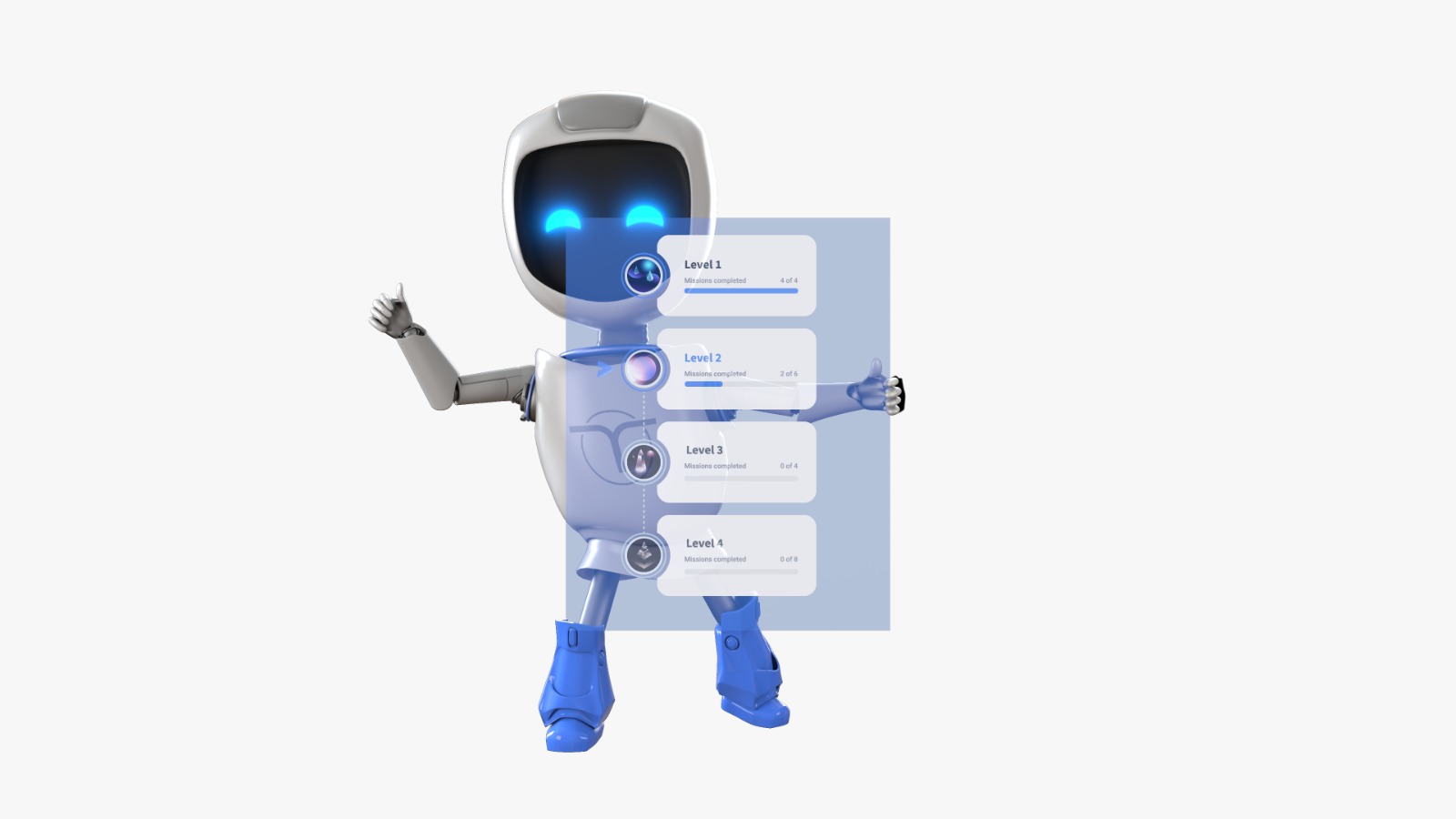Did you know that it takes just 6 seconds for a caller to form a first impression of your business, even over the phone? And with 65% of customers switching brands after a single poor customer experience, one mishandled call could mean losing valuable business. That’s why telephone manner training becomes essential.
This type of training helps frontline staff (like receptionists, customer service agents, salespeople, and hospitality workers) develop the skills to communicate clearly, professionally, and with empathy by phone.
At the end of the day, your team’s ability to handle calls effectively can directly impact customer satisfaction and retention, influencing loyalty, sales, and your brand’s reputation. However, with the right training, routine calls can become powerful opportunities to build trust and drive business growth.
Who Needs Telephone Manner Training and Why
Telephone manner training is essential for anyone who interacts with customers over the phone. Whether it’s answering questions, resolving issues, or booking services, how your team handles these conversations can shape the entire customer experience.
Who Benefits from Telephone Manner Training?
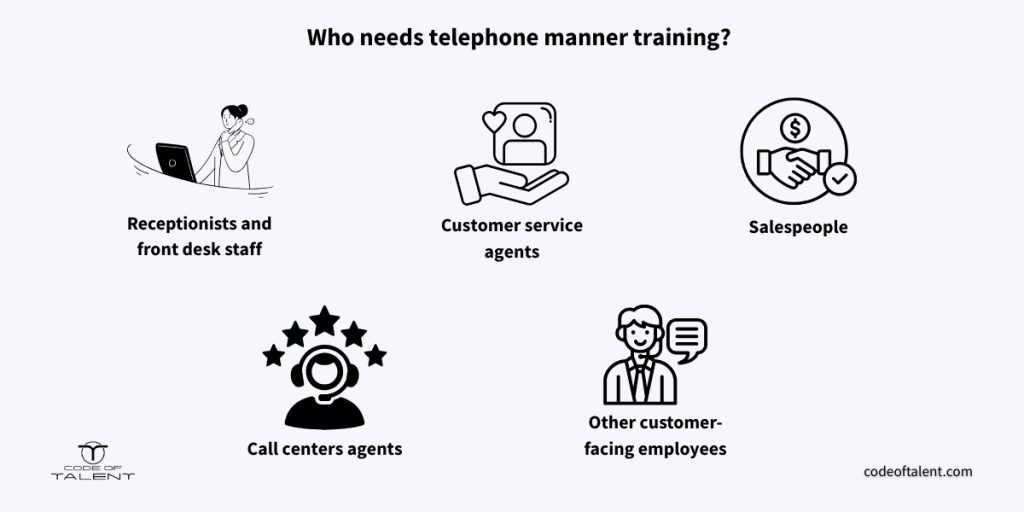
- Receptionists and front desk: The first voice customers hear
- Customer service agents: Answering questions and solving problems
- Salespeople: Using persuasion to close deals
- Call center agents: Juggling lots of calls under pressure
- Medical office staff, IT support, schedulers, banking representatives: Balancing efficiency with empathy
In short, if someone on your team answers the phone, they need telephone manner training.
Why They Need It
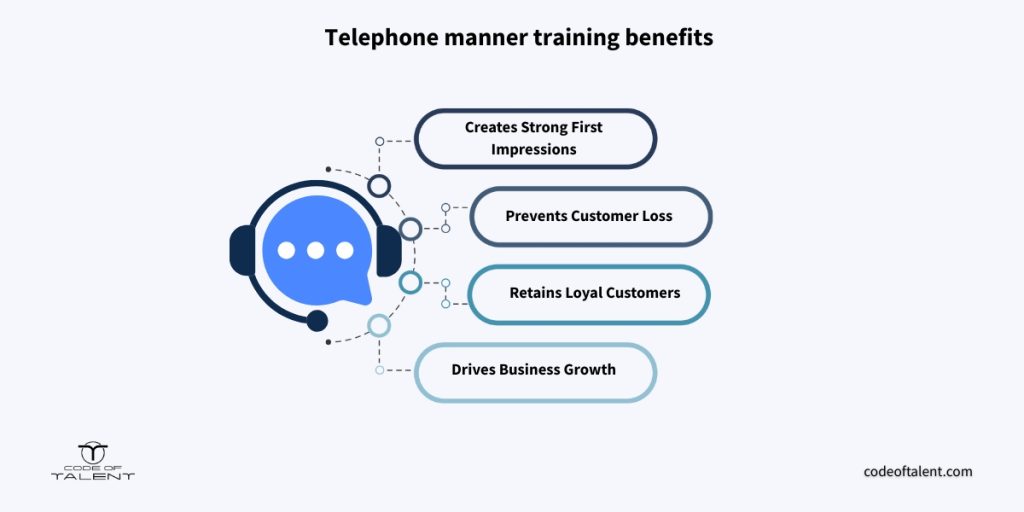
Multiple studies and surveys over the years have shown a direct link between customer service quality, business performance, and customer loyalty. Here’s why telephone manner training matters, according to research:
1. Creates Strong First Impressions
A professional phone manner sets the tone for the entire customer experience. According to the Qualtrics ROI of Customer Experience Report, 77% of customers across industries are willing to forgive a poor experience if they rate the service team as “very good.”
2. Prevents Customer Loss
Without proper telephone manner training, even small missteps, like being abrupt, unclear, or unhelpful, can push customers away. The Zendesk Customer Experience Trends Report found that after more than one bad service interaction, 80% of consumers would rather do business with a competitor.
3. Retains Loyal Customers
Customer retention is heavily influenced by the quality of service. In the Salesforce State of the Connected Customer report, 89% of consumers said they’re more likely to make another purchase after a positive customer service experience.
4. Drives Business Growth
With loyal customers and repeated purchases or business comes financial growth. As reported by Bain & Company, companies that prioritize better customer experiences grow revenues 4–8% above the market average.
Key Elements of Professional Telephone Manner
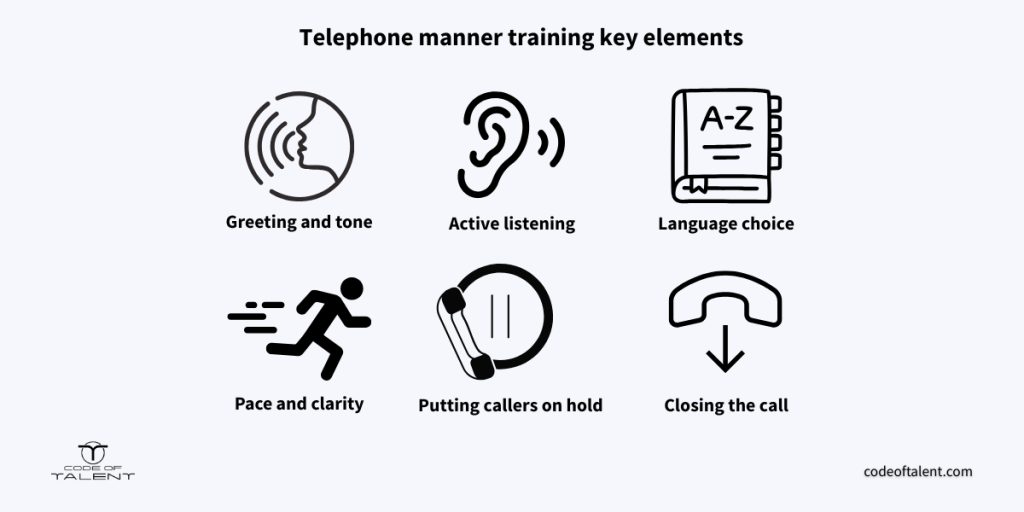
When it comes to telephone manner training, there are several key components your frontline staff must master to make every call effective and professional. These elements not only improve communication skills but also shape how your customers perceive your business.
1. Greeting & Tone
Greeting sets the stage for the entire conversation. Research shows that tone affects how listeners judge competence and warmth and that calm and steady voices sound both confident and trustworthy.
Tips:
- Smile while speaking to naturally lift the tone.
- Use a friendly but professional greeting like, “Good morning, this is [Name], how can I help you today?”
2. Active Listening
Active listening involves responding with verbal acknowledgments and asking clarifying questions to show engagement and understanding.
Examples include:
- Verbal nods like “I understand” or “That makes sense” to affirm the caller’s points
- Questions such as “Could you please clarify that?” or “Did I understand correctly?”
3. Language Choice
Effective communication relies on simple, polite, and positive language. Avoidance of jargon and negative phrasing helps prevent confusion or frustration.
Positive alternatives include:
- Saying “Here’s what can be done” instead of “I can’t do that”
- Using affirmations such as “absolutely,” “certainly,” and “thank you” to maintain a constructive tone
4. Pace and Clarity
Speaking at a measured pace with clear pronunciation ensures callers can easily follow the conversation. This balance prevents feelings of rush or boredom.
Recommended practices include:
- Pausing briefly after key points to allow information to register
- Avoiding mumbling or trailing off at the end of sentences
5. Putting Callers on Hold
When placing callers on hold, it’s important to obtain permission beforehand and provide periodic updates if the wait is too long.
Examples:
- Asking, “May I place you on hold for a moment while I check that?”
- Checking back after 30 seconds with “Thank you for waiting, I’m still working on this.”
6. Closing the Call
How a call ends leaves a lasting impression. Before saying goodbye, confirm any next steps: whether it’s sending a follow-up email, scheduling another call, or simply thanking the customer.
Effective closings typically involve:
- Recapping actions to be taken, e.g., “The details will be emailed by this afternoon.”
- Offering thanks, such as “Thank you for calling, have a great day.”
- Encouraging future contact, for instance, “Feel free to call anytime if you have questions.”
Best Practices and Tips for Telephone Manner Training
Successful phone interactions are the result of clear guidance, repetition, and support. The following best practices for telephone manner training help frontline staff build confidence, consistency, and professionalism with every call.
Role-Playing Exercises
Simulated calls are one of the most effective ways to build soft skills in a safe environment. Role-playing different customer scenarios (such as complaints, booking issues, or product questions) helps staff practice tone, empathy, and active listening.
It’s especially useful for:
- Practicing how to stay calm under pressure
- Learning to de-escalate frustrated callers
- Gaining confidence before handling real conversations
Use Call Recordings (With Consent)
Reviewing real call recordings (where consent is obtained) allows teams to hear what’s working and what’s not. This makes feedback more concrete and actionable.
Call reviews can highlight:
- Missed opportunities for empathy or clarity
- Great examples of professional tone and resolution
- Moments where language or pacing can be improved
Personalize Scripts
Scripts are helpful for structure, but they shouldn’t sound robotic. Adapting them to match your brand voice and common customer needs keeps conversations natural and authentic.
Good scripts should:
- Include flexible language for different situations
- Reflect the tone and personality of your brand
- Encourage active engagement rather than word-for-word reading
Feedback Loops
Great phone skills don’t stick after a single training session. Ongoing feedback, whether it’s through real-time coaching or short debriefs after calls, helps staff fine-tune their approach and stay consistent over time.
This works best when feedback is:
- Timely and specific
- Focused on growth, not just correction
- Integrated into daily routines, not saved for annual reviews
Refresher Training
Even experienced staff benefit from regular training. Periodic refresher sessions help reinforce good habits and introduce any updates to processes, systems, or customer expectations.
Refresher training is especially useful when:
- New tools or products are introduced
- Customer feedback reveals common issues
- There’s a dip in call quality or customer satisfaction
Embrace Microlearning
Telephone manner training doesn’t have to mean long, formal sessions. In fact, some of the most effective learning happens in short moments, right on the job. This is called microlearning.
Microlearning breaks training into bite-sized, practical missions that can be applied immediately. It includes everything already mentioned:
- Role-playing short call scenarios
- Reviewing brief clips of call recordings
- Practicing updated scripts in pairs
- Giving quick, real-time feedback
What makes microlearning especially powerful is how it promotes collaborative learning. When team members review calls together or swap tips, they learn from one another, not just from a trainer. This peer-based format helps make learning stick and encourages consistency across the whole team.
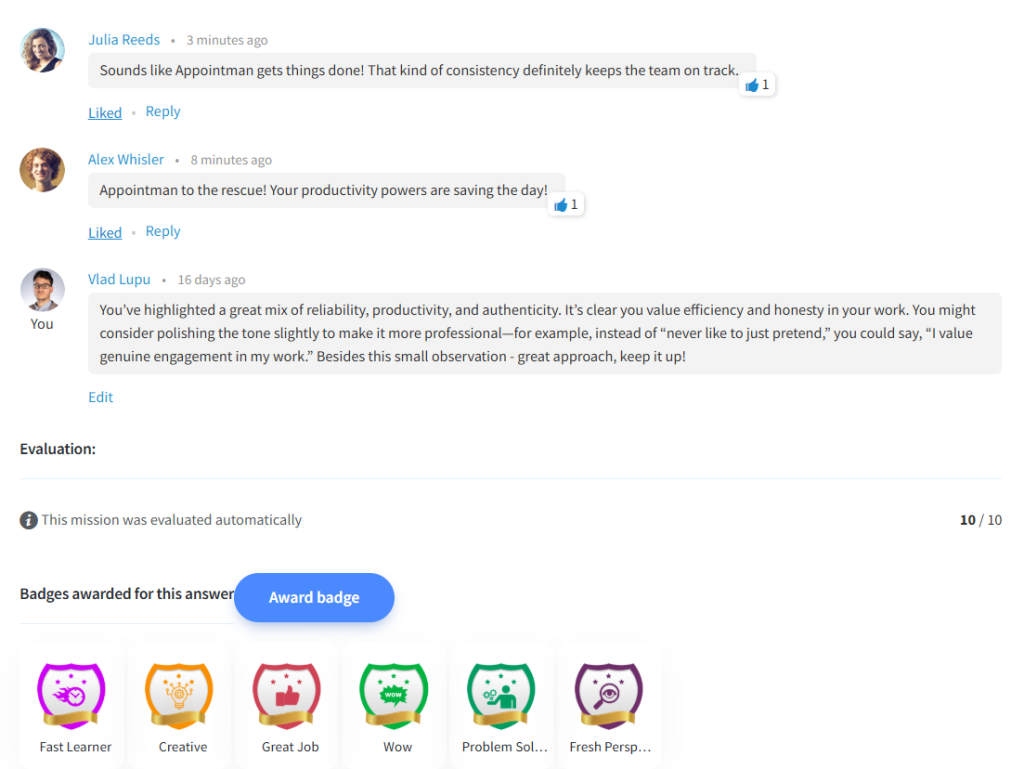
Telephone Scripts for Frontline Staff
Clear, friendly, and consistent communication starts with the right words. Here are a few foundational scripts that can be customized to fit your team’s tone and brand voice:
General Greeting Script
- “Good morning! Thank you for calling [Company Name], this is [Your Name]. How may I assist you today?”
Handling Complaints
- “I completely understand your frustration, and I’m here to help. Let’s sort this out together.”
You can also add a follow-up to manage expectations:
- “I’ll do everything I can to resolve this now, and if we need more time, I’ll make sure you’re kept updated.”
Transferring a Call
- “May I place you on a brief hold while I connect you with the right person?”
- “Thank you for your patience—I’m now transferring you to [Department or Name], who’ll be happy to assist you.”
Missed Call / Callback Script
- “Hi, this is [Your Name] calling from [Company Name]. I noticed we missed your call earlier—how can I help you today?”
If they’re unsure or didn’t leave a message:
- “I just wanted to make sure everything’s okay and see if there’s anything we can assist you with.”
Appointment Reminder Script
- “Hello, this is [Your Name] from [Company Name]. I’m calling to remind you of your appointment on [Date] at Time] with [Provider/Technician]. If you have any questions or need to reschedule, feel free to give us a call.”
Following Up After a Previous Call
- “Hi, this is [Your Name] from [Company Name]. I’m following up on your recent call with us regarding [brief issue]. I just wanted to check in and see if everything has been resolved to your satisfaction.”
When You Don’t Know the Answer
- “That’s a great question. I want to make sure I give you the right information, so let me check with someone who can help. May I place you on a brief hold?”
- “I’m not 100% sure, but I’ll find out and get back to you as soon as I can. What’s the best number to reach you at?”
Confirming a Booking or Order
- “Just to confirm: you’re booked for [Date] at [Time] under the name [Customer Name]. We’ve reserved [Details] for you. If you have any questions or need to make changes, feel free to contact us anytime.”
Asking for Feedback
- “If you have a moment, we’d really appreciate your feedback about today’s call. You may receive a short survey, and your input helps us improve.”
Shorter option:
- “Thanks again—and if you’d like to share any feedback, we’d love to hear how we did today.”
Ending the Call on a Positive Note
- “Is there anything else I can help you with today?”
[Pause to listen]
“Great—thank you so much for calling, and have a wonderful day!”
Or, for service-based interactions:
- “Thanks for calling [Company Name], and we look forward to speaking with you again.”
Conclusion: Small Conversations, Big Impact
In competitive customer-facing roles, the way a call is handled can set a business apart. And the good news? These skills can be taught, practiced, and improved with the right tools.
Code of Talent makes this easier than ever. Our platform helps teams build soft skills through bite-sized, interactive learning that fits into the flow of daily work. Collaborative, customizable, and designed for real-world scenarios: it’s perfect for reinforcing everything you’ve read today!
Some of Code of Talent’s features include:
- Microlearning missions (no longer than 10 minutes)
- Gamification: leaderboards, badges, and prizes to improve engagement
- Feedback from mentors, trainers, managers, and other team members
- AI-driven platform: cuts down heavy documents, generates missions according to training supervisor’s input, and offers immediate feedback on responses
Code of Talent also offers a free trial for you to explore its features and how it can improve customer-facing performance, including telephone manner training. Try our free trial now and see your team excel in interacting with customers!





